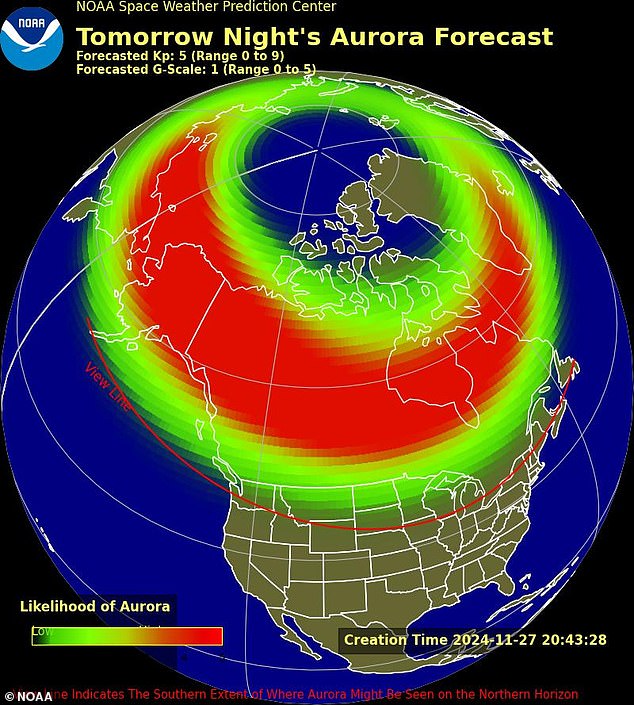Northern lights forecasted to grace America’s skies on Thanksgiving – here are the states with maximum visibility
The Cosmos is ready to put on a stunning show as Americans gather around the table for Thanksgiving.
The sun unleashed a burst of energy late Sunday night that is expected to hit Earth on Thursday, creating beautiful northern lights in parts of the northern US.
Most of Washington, Montana, the Dakotas, Minnesota, Wisconsin, Michigan and Maine are positioned for potential auroras.
And the northern regions of Idaho, Wyoming, New York, Vermont and New Hampshire can also see the colored lights.
The National Oceanic and Atmospheric Administration (NOAA) explained that aurora can often be observed just after sunset or just before sunrise.
Space weather experts say auroras could be visible from 10 a.m. ET Thursday to 1 a.m. ET Friday.
NOAA has also warned of a geomagnetic storm that could affect radios, satellites and GPS, which will last until Black Friday.
‘There can be fluctuations in the electricity grid. Power systems at high latitudes may experience stress alerts,” NOAA shared.
‘Irregularities in satellite orientation can occur; Greater drag on satellites in low Earth orbit is possible.”
Americans are expected to see the beautiful Northern Lights on Thanksgiving after the sun released a burst of energy on Sunday
Pale auroras may be seen in many northern states Thursday and Friday, but they could be short-lived and seeing them will depend on how intense the solar storms become, NOAA meteorologist Mike Bettwy said.
Both the Northern Lights and the geomagnetic storm are the result of a coronal mass ejection (CEM).
Solar flares are powerful bursts of radiation resulting from the release of magnetic energy associated with sunspots, and are the largest explosive events in the solar system.
After the solar flare erupted, a second explosion of high-energy particles and solar plasma formed a direct line to Earth – that was the CME.
The Northern Lights can be visible anywhere in the night sky, but are often difficult to see with the naked eye in the US.
A smartphone camera can help skygazers get a better view. Simply point your camera at the sky and watch the aurora appear on the screen.
Also known as the aurora borealis, this spectacle is a natural light show that occurs when charged particles from the Sun interact with the Earth’s magnetic field, decorating the night sky with vibrant curtains of green, pink, red, yellow, blue and violet.

Most of Washington, Montana, the Dakotas, Minnesota, Wisconsin, Michigan and Maine are positioned for potential auroras. And the northern regions of Idaho, Wyoming, New York, Vermont and New Hampshire can also see the colored lights
Aurora is most commonly seen in the auroral zone – an area within 2,500 kilometers of the North Pole. Normally the lights can only be seen in areas such as Scandinavia, Alaska and Iceland.
But geomagnetic storms can make them appear further south.
The sun is currently in the maximum phase of its eleven-year cycle, making solar bursts and northern lights more common.
The sun has unleashed 20 solar flares in the past 24 hours, one of which caused power outages over the Indian Ocean.
The active period is expected to last at least another year, although scientists won’t know when solar activity peaked until months later, according to NASA.
Although geomagnetic storms can cause radio interference, experts do not expect any major communications disruptions from this week’s solar storm.
